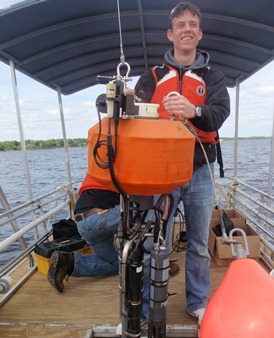Anthony Weinke

Lab/Buoy Manager
Grand Valley State University
Annis Water Resources Institute
740 West Shoreline Drive Muskegon, MI 49441
Office: 228 Lake Michigan Center
Phone: (616) 331-8798 Fax: (616) 331-3864
Email: [email protected]
Degree
M.S. Biology-Aquatic Science GVSU 2016
B.A. Biology-Aquatic Science, Minor: Chemistry GVSU 2013
Posters/Presentations
Oral
Weinke, A. D., Knapp, K., and B. A. Biddanda. Time-series and discrete data reveal dynamics and consequences of hypoxia in Muskegon Lake, Michigan. International Association for Great Lakes Research. Detroit, Michigan. June 2017.
Weinke, A. D., Koopmans, D. J., and B. A. Biddanda. Time-series buoy observatory allows monitoring of unforeseen and difficult to track lake phenomena. International Association for Great Lakes Research. Guelph, Ontario, Canada. June 2016
Weinke, A. D. and B. A. Biddanda. Time-series productivity and hypoxia dynamics linked to storms and runoff in a Great Lakes estuary. International Association for Great Lakes Research. Burlington, Vermont. June 2015.
Posters
Weinke, A. D., Koopmans, D. J., and B. A. Biddanda. Layered lake: ecosystem dynamics in a freshwater estuary during the growing season with respect to climate change, stratification, and episodic mixing events. Association for the Sciences of Limnology and Oceanography. New Orleans, Louisiana. February 2016.
Weinke, A. D., Ruetz III, C. R., Koopmans, D. J., and B. A. Biddanda. Out of breath: Hypoxia and its effects on fish species composition and abundance in the bottom waters of Muskegon Lake, Michigan, with lake-wide implications. Midwest Fish and Wildlife Conference. Grand Rapids, Michigan. January 2016.
Weinke, A., Biddanda, B., Kendal, S., Gereaux, L., and T. Holcomb. Tracking trends in Muskegon Lake weather, productivity, and hypoxia in real-time using a lake observatory buoy. Grand Valley State University-Student Scholars Day. Allendale, Michigan, April 2012.
Weinke, A., Biddanda, B., Kendal, S., Gereaux, L., and T. Holcomb. Tracking trends in Muskegon Lake weather, productivity, and hypoxia in real-time using a lake observatory buoy. West Michigan Regional Undergraduate Science Research Conference. Grand Rapids, Michigan. November 2011.
Publications
Biddanda, B. A., Weinke, A. D., Kendall, S. T., Gereaux, L. C., Holcomb, T. M., Snider, M. J., Dila, D. K., Long, S. A., Vandenberg, C., Knapp, K., Koopmans, D. J., Thompson, K., Vail, J. H., Ogdahl, M. E., Liu, Q., Johengen, T. H., Anderson, E. J., and S. A. Ruberg. Chronicles of hypoxia: Time-series buoy observations reveal annually recurring seasonal basin-wide hypoxia in Muskegon Lake – A Great Lakes estuary. Journal of Great Lakes Research. In Press.
Cotner, J. B., Weinke, A. D., and B. A. Biddanda. Great Lakes: Science Can Keep Them Great. Journal of Great Lakes Research. 43:916-919.
Weinke, A. D. and B. A. Biddanda. 2017. From bacteria to fish: Ecological consequences of seasonal hypoxia in a Great Lakes estuary. Ecosystems. In Press.
Salk, K. R., Ostrom, P. H., Biddanda, B. A., Weinke, A. D., Kendall, S. T., and N. E. Ostrom. 2016. Ecosystem metabolism and greenhouse gas production in a mesotrophic northern temperate lake experiencing seasonal hypoxia. Biogeochemistry. 133: 303-319.
Defore, A. L., Weinke, A. D., Lindback, M. M., and B. A. Biddanda. 2016. Year round measures of plankton metabolism reveal net autotrophy in surface waters of a Great Lakes estuary. Aquatic Microbial Ecology. 77: 139-153.
Biddanda, B. A., McMillan, A. C., Long, S. A., Snider, M. J., and A. D. Weinke. 2015. Seeking sunlight: rapid phototactic motility of filamentous mat-forming cyanobacteria optimize photosynthesis and enhance carbon burial in Lake Huron’s submerged sinkholes. Frontiers in Microbiology. 6: 1-13.
McNair, J. N., Sesselmann, M. R., Kendall, S. T., Gereaux, L. C., Weinke, A. D., and B. A. Biddanda. 2015. Alternative approaches for estimating components of lake metabolism using the free-water dissolved-oxygen (FWDO) method. Fundamental and Applied Limnology. 186: 21-44.
Vail, J., A. Meyer, A. Weinke and B. Biddanda. 2015. Water quality monitoring: Lesson plan for exploring time-series data. J. Michigan Teachers Association 6: 37-48.
Biddanda, B. and A. Weinke. 2014. Changing carbon balance in the Great Lakes. GVSU Interchange. https://www.gvsu.edu/cms4/asset/DCE6A3E6-F63F-F351-18434C12BE0474DA/interchange_21_5.pdf
Weinke A. D., Kendall S. T., Kroll D. J., Strickler E. A., Weinert M. E., Holcomb T. M., Defore A. A., Dila D. K., Snider M. J., Gereaux L. C., Biddanda B. A. 2014. Systematically variable planktonic carbon metabolism along a land-to-lake gradient in a Great Lakes coastal zone. Journal of Plankton Research. 36: 1528-1542.
McNair, J. N., Gereaux, L. C., Weinke, A. D., Sesselmann, M. R., Kendall, S. T., and B. A. Biddanda. 2013. New methods for estimating components of lake metabolism based on free-water dissolved-oxygen dynamics. Ecological Modelling, 263: 251-263.
